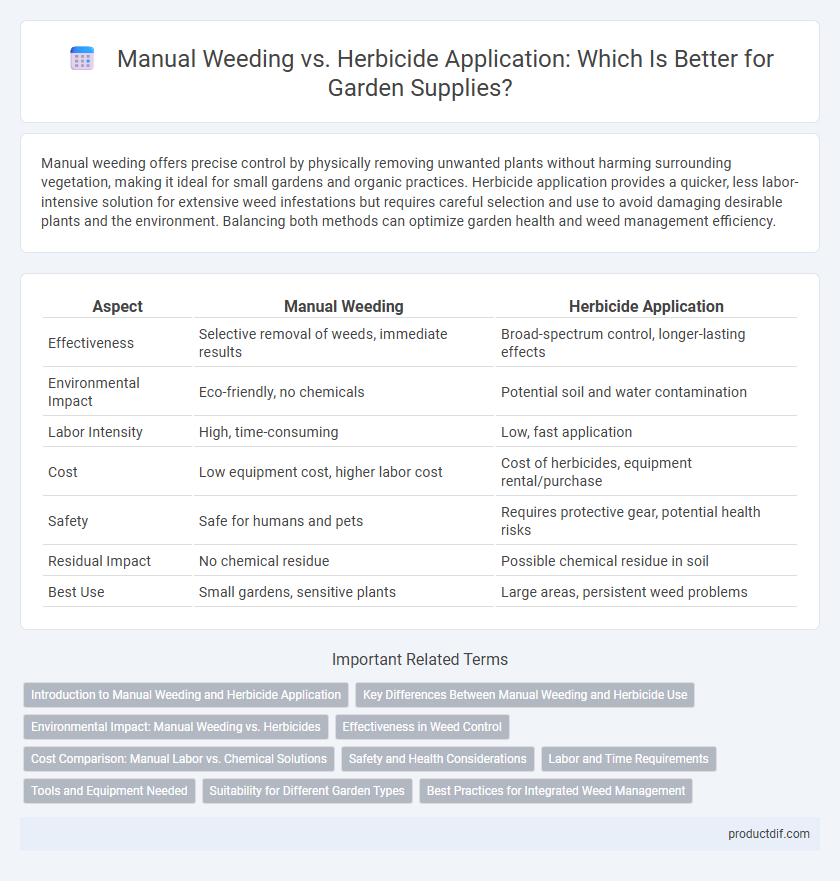Manual weeding offers precise control by physically removing unwanted plants without harming surrounding vegetation, making it ideal for small gardens and organic practices. Herbicide application provides a quicker, less labor-intensive solution for extensive weed infestations but requires careful selection and use to avoid damaging desirable plants and the environment. Balancing both methods can optimize garden health and weed management efficiency.
Table of Comparison
| Aspect | Manual Weeding | Herbicide Application |
|---|---|---|
| Effectiveness | Selective removal of weeds, immediate results | Broad-spectrum control, longer-lasting effects |
| Environmental Impact | Eco-friendly, no chemicals | Potential soil and water contamination |
| Labor Intensity | High, time-consuming | Low, fast application |
| Cost | Low equipment cost, higher labor cost | Cost of herbicides, equipment rental/purchase |
| Safety | Safe for humans and pets | Requires protective gear, potential health risks |
| Residual Impact | No chemical residue | Possible chemical residue in soil |
| Best Use | Small gardens, sensitive plants | Large areas, persistent weed problems |
Introduction to Manual Weeding and Herbicide Application
Manual weeding involves physically removing weeds by hand or using tools, ensuring precise control without chemicals, which is ideal for small gardens or sensitive plants. Herbicide application uses chemical agents to target and eliminate weeds efficiently across large areas, suitable for extensive garden spaces requiring quick management. Choosing between manual weeding and herbicides depends on garden size, plant sensitivity, and environmental impact considerations.
Key Differences Between Manual Weeding and Herbicide Use
Manual weeding offers precise control by physically removing weeds, minimizing chemical exposure and preserving beneficial plants, while herbicide application provides rapid coverage over large areas but risks environmental impact and potential harm to non-target species. Manual weeding is labor-intensive and time-consuming, requiring repeated effort, whereas herbicides deliver efficient, long-lasting weed suppression with proper selection and application. The choice depends on garden size, desired control level, and environmental considerations, balancing effectiveness with safety and sustainability.
Environmental Impact: Manual Weeding vs. Herbicides
Manual weeding minimizes environmental impact by avoiding chemical runoff, preserving soil health, and protecting beneficial organisms such as pollinators and earthworms. Herbicide application can lead to soil and water contamination, harming non-target plants, aquatic life, and contributing to the decline of biodiversity. Choosing manual weeding supports sustainable garden practices and reduces the risk of chemical resistance in weed populations.
Effectiveness in Weed Control
Manual weeding offers precise removal of weeds, effectively targeting deep-rooted and isolated plants without damaging desired crops. Herbicide application provides broad-spectrum control, efficiently managing large areas with minimal labor and reducing weed germination over time. Combining both methods can optimize weed control effectiveness by addressing diverse weed populations and growth stages.
Cost Comparison: Manual Labor vs. Chemical Solutions
Manual weeding requires significant time and physical effort, often leading to higher labor costs, especially in large garden areas or commercial settings. Herbicide application involves purchasing chemical products, which vary in price depending on formulation and brand, but generally reduces labor expenses by enabling faster weed control over extensive landscapes. Considering both upfront costs and long-term maintenance, herbicides tend to offer cost-efficiency for large-scale operations, while manual weeding may be more economical for small gardens with limited weed growth.
Safety and Health Considerations
Manual weeding eliminates chemical exposure, reducing health risks such as skin irritation, respiratory problems, and potential long-term effects linked to herbicide use. Herbicide application requires careful handling, protective gear, and adherence to safety guidelines to prevent accidental poisoning and environmental contamination. Choosing manual weeding supports organic gardening practices and safer work conditions, especially in households with children and pets.
Labor and Time Requirements
Manual weeding demands significant labor intensity and time commitment, often requiring hours of physical effort to remove weeds effectively. Herbicide application drastically reduces labor and time, allowing for quick and broad-spectrum weed control with minimal manual involvement. Choosing between these methods depends on garden size, weed severity, and available labor resources.
Tools and Equipment Needed
Manual weeding requires simple tools like hand trowels, hoes, and weeding forks, allowing precise removal of unwanted plants without chemicals. Herbicide application demands spray equipment such as pump sprayers or backpack sprayers, along with protective gear to ensure safe handling and targeted treatment. Selecting the appropriate tools optimizes efficiency and minimizes environmental impact in garden maintenance.
Suitability for Different Garden Types
Manual weeding is ideal for small, delicate garden beds or organic gardens where chemical use is restricted, offering precise control without harming beneficial plants. Herbicide application suits larger, less intricate landscapes or industrial-scale gardens, providing efficient weed management with minimal labor. Selecting the appropriate method depends on garden size, plant sensitivity, and environmental impact considerations.
Best Practices for Integrated Weed Management
Manual weeding ensures precise removal of weeds without chemical residues, ideal for small gardens or sensitive areas. Herbicide application, when using selective or systemic products, effectively controls widespread or difficult-to-remove weeds while minimizing environmental impact. Integrating both methods through timely manual removal and targeted herbicide use promotes sustainable weed management and healthy plant growth.
Manual Weeding vs Herbicide Application Infographic

 productdif.com
productdif.com